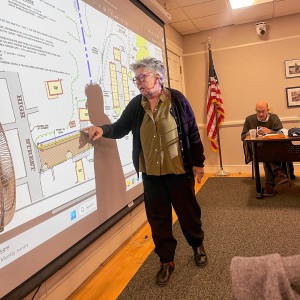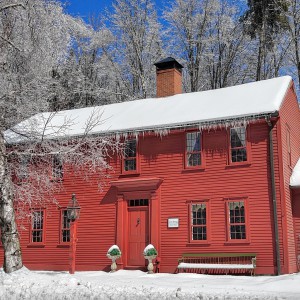The public benefits of private land
| Published: 01-18-2023 10:01 AM |
The Mink Hills in Warner have returned to forest, where hemlock, oak, and beech trees now make their home, replacing the early settlers who clear-cut this land to make way for sheep pastures.
John Bassi is working to make sure these residents – the trees and wildlife – thrive. Since Bassi and his wife, Julie, inherited around 470 acres of the Mink Hills forest from Julie’s father a few years ago, their main goal has been to protect the ecosystem and provide a habitat for wildlife.
“We are stewards of the land for a brief period of time while we’re here,” Bassi said. “So we want to do the best we can for the land, and for the habitat and wildlife.” In 2021, the couple hired a forester to help them decide how to best do that and they’ve since received grants to cover some of the cost of efforts to prevent soil erosion, promote the growth of a diverse and resilient forest, and leave woody materials behind to provide shelter and habitat for critters.
Private landowners hold over 75 percent of the state’s forests, so what they decide to do on their land is consequential. The state’s forests play a critical role in water quality and wildlife habitat, as well as the economies that depend on these public goods, including tourism.
Foresters in the state say that for many landowners, like the Bassis, wildlife and habitat are a top priority far outranking economic incentives related to land ownership. The top reason landowners gave for owning forestland was its beauty, a National Woodland Owner Survey collected by the U.S. Department of Agriculture Forest Service in 2018 found. Wildlife and protecting nature were other top reasons given by around 80 percent of those surveyed. Investment was much lower down the list, with less than 40 percent of respondents citing it as a reason for owning land. Less than 20 percent said they owned land for its timber.
“It’s pretty amazing,” said Steve Roberge, the state forestry specialist at UNH Extension. “We think about trees and managing them, but a lot of conversations we have with private landowners has to do with wildlife and wildlife management. Either they enjoy seeing it or they want to do something with land to conserve, preserve, or create new wildlife habitat.”
The decisions private landowners make about managing that land is personal, affecting their finances and potentially their children’s inheritance, but it also impacts public goods, Roberge said. That’s part of why there are county foresters who can help educate landowners on the role the forest plays beyond the bounds of one particular property. Those foresters field inquiries from around 1,000 landowners in a typical year, Roberge said.
Mink Hills tells some of the story of the state’s forests -- almost entirely clear-cut to make pasture land for sheep in the 1800s, with forests returning to much of the state over the past 100 to 120 years.
Article continues after...
Yesterday's Most Read Articles
 Peterborough Planning Board approves 14-unit development near High Street
Peterborough Planning Board approves 14-unit development near High Street
 Peterborough firefighters continue fishing derby tradition
Peterborough firefighters continue fishing derby tradition
 Franklin Pierce students help foster literacy at Rindge Memorial School
Franklin Pierce students help foster literacy at Rindge Memorial School
 ConVal attorney answers withdrawal questions
ConVal attorney answers withdrawal questions
 Scott Bakula starring in Peterborough Players’ ‘Man of La Mancha’
Scott Bakula starring in Peterborough Players’ ‘Man of La Mancha’
 HOUSE AND HOME: The Old Parsonage in Antrim is a ‘happy house’
HOUSE AND HOME: The Old Parsonage in Antrim is a ‘happy house’
Although the state has rebounded from its agricultural past, forests have been on the decline since the 1970s. In that time, the state has lost nearly 400,000 acres of forested land – around the size of Sullivan County – to development. And there’s now a downward trend that, according to conservative estimates, amounts to a loss of nearly 3,000 acres a year, or 8 acres per day. Other estimates have that number as high as 65 acres per day – with the state losing the equivalent of the 13,000-acre Pisgah State Park in a year.
“It’s not one block here, one block there,” Roberge said. “It’s the nipping of the edges of suburbia. People need places to live, but if we’re thinking about wildlife, so do wildlife.”
What does ecological forestry look like?
Bassi, the landowner in Warner, said some neighbors have expressed interest in buying some of the land he has no plans to sell. Instead, in 2021 he started working with forester Matthias Nevins, who wrote a forest management plan with details about various efforts to preserve and improve the site’s forests.
Bassi has already implemented some parts of the plan – like putting up a gate to keep out heavy machinery or cars, which can damage the woods. Other interventions include installing water bars to prevent runoff from causing erosion in areas where trees have been cut. Cutting some trees is part of the management plan and can help diversify the forest, Nevins said. It can help preserve fields and provide habitat for some songbirds.
Nevins said the ecological forestry approach he’s using looks to the forest as a guide. “How do forests develop naturally over time, how do they regenerate, and we try to mimic those processes through management,” he said. “We’re managing forests like forests manage themselves.”
In nature, fire, ice, or heavy wind can blow down groups of trees, creating an opportunity for young new trees to grow by opening space in the canopy. Nevins said ecological forestry attempts to mimic those events by cutting in small, circular areas and letting the surrounding trees naturally reseed those areas.
Contrary to common perception, Nevins said, cutting can help create a forest that is resilient in the face of climate change by creating a forest that is more diverse, with trees of different ages and species.
“If we don’t recruit a new group of trees and work to promote diversity in the forest, then they might be more vulnerable and we might have more carbon loss over time,” he said. “The most important thing is to maintain forests as forests. If we turn a forest into a parking lot, then that’s not going to be achieving those carbon storage objectives, but a working forest is achieving those objectives over a period of time.”
Funding for forests
Federal grant money is available through the Natural Resources Conservation Service arm of the U.S. Department of Agriculture to help landowners pay for some sustainable forestry practices. Jeremy Fowler, a spokesperson for the Natural Resources Conservation Service in New Hampshire, said interest in grant funding has increased in recent years, with the office typically receiving around 400 applications for funding per year.
The Environmental Quality Incentives Program, or EQIP, helped Bassi pay for some of the cost of implementing the forest management plan. That program provided around $5.5 million in assistance across 245 contracts with landowners for conservation efforts in fiscal year 2022.
And Bassi also received funding through the Conservation Stewardship Program, which is designed to expand prior conservation efforts. It involves creating and implementing a conservation plan to help agricultural operations keep air and water clean and improve wildlife habitat.
Fowler said his office receives more applications than it can fund and it prioritizes applications that will make the greatest impact on natural resources, such as those that will protect drinking water or benefit threatened and endangered species.
In Bassi’s woods, he points out “snags,” trees that have died but still serve an important purpose, providing habitat to birds and other wildlife.
He likes coming to the land to hunt and just to spend time. “This is where I found my peace. This is like where I get my yoga. This is my clear-my-mind, forget-about-everything sort of place,” he said. His relationship with this piece of the Mink Hills is as long as his 26-year marriage.
He plans to leave the land to his children, who share his love of the outdoors, if not his patience for deer hunting in New Hampshire where “you never see anything.” It’s here, he said, he’ll have some of his ashes scattered. In the meantime, he’s aiming to make it a better place to live: for the turkeys, deer, raccoons, birds, and humans who frequent it.
]]>


